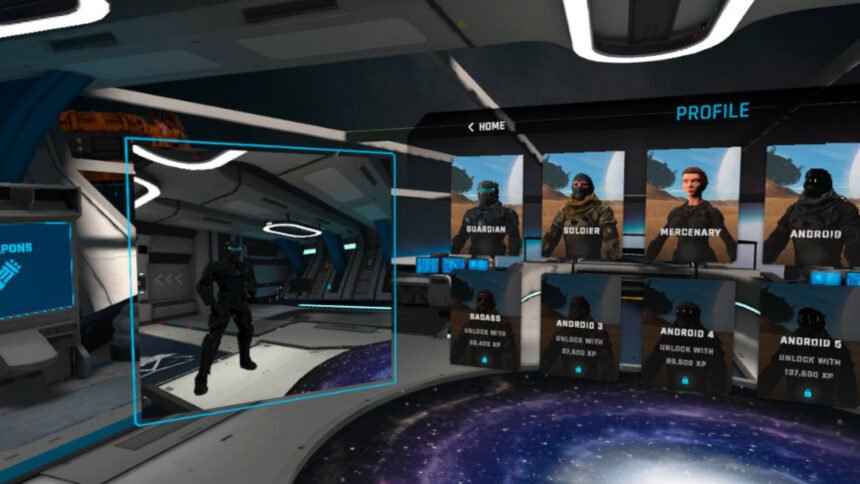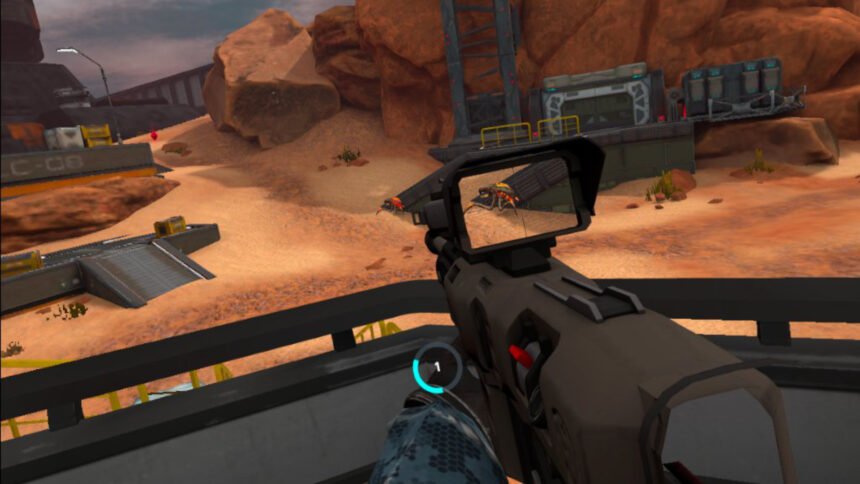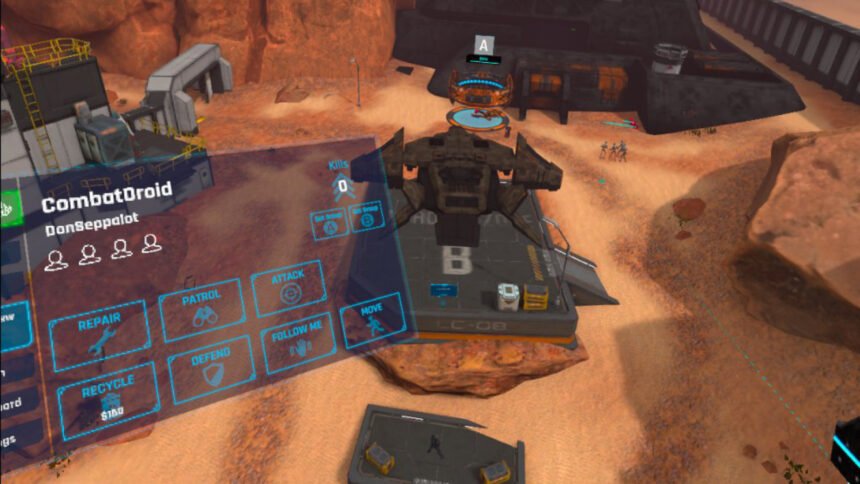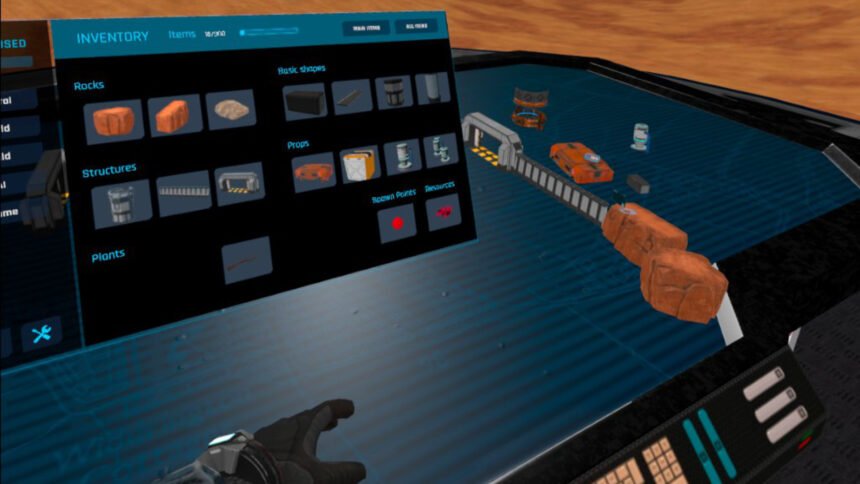Guardians Frontline review: Halo meets Starcraft in virtual reality

Guardians Frontline leaves the Early Access phase and is released for Meta Quest 2 and SteamVR. Our review shows whether the mix of real-time strategy and first-person shooter is compelling.
The VR game Guardians Frontline was in Meta's App Lab for two years and received many positive user reviews. The mix of real-time strategy, first-person shooter, and tower defense already impressed many players in Early Access. The full version became available in the Meta Quest Store and SteamVR on March 9, 2023, and I tested it on Meta Quest 2.
Content
Guardians Frontline: Review in a nutshell
Guardians Frontline doesn't dazzle with impressive graphics but is mostly convincing in terms of gameplay. Even if the AI soldiers sometimes limp a bit and the sound isn't always perfectly mixed, the combination of first-person shooter and real-time strategy works out perfectly. I can shoot my way through hordes of enemies as a commander in the first-person perspective or give strategic instructions to my troops directly on the battlefield.
If I lose track of what's happening, I switch smoothly to the top-down view and play Guardians Frontline like a classic real-time strategy game. Apart from the campaign, there's also a lot to do with various game modes, multiplayer sessions, and an extensive map editor. VR strategists can therefore buy the game without hesitation and should spend many exciting hours with Guardians Frontline.
Guardians Frontline is suitable for you if you...
- would like to experience real-time strategy in VR
- like to shoot around on the virtual battlefield yourself
- like sci-fi settings such as Starship Troopers
Guardians Frontline is less suitable for you if you ...
- are looking for a pure RTS game or a pure shooter
- expect a sci-fi graphics pearl like Red Matter 2
- are looking for particularly impressive gunplay
Starship Troopers meets Starcraft meets Halo
In Guardians Frontline, you fight on the side of the Federation, which is at war with an alien, bug-like race. Both factions are after a mysterious energy source that can be mined on different planets.
The aggressive creatures are strongly reminiscent of the arachnids from Paul Verhoeven's cult sci-fi film Starship Troopers. Even in the tutorial, I immediately feel like Sergeant Johnny Rico during the major attack on Planet P. Unlike Rico, however, I have something to say in Guardians Frontline right from the start.
As Commander, I command a group of humanoid combat robots. The "bugs" are trying to overrun a Federation base, requiring my mech-men and I to stop them. I can defend myself in the first-person perspective with a pistol and machine gun or send my robots after the bugs.
Between tower defense, sci-fi shooter, and real-time strategy
The action-heavy tower defense mechanism is expanded by real-time strategy elements and different mission types in the course of the campaign. Sometimes I have to make sure that a mobile extractor can mine the coveted crystals unhindered, sometimes I go with my unit to destroy beetle nests that have nested in an underground base.

I start as a commander in Halo style. During the campaign, I unlock different skins for my avatar. | Image: Fast Travel Games
I must always make sure that my base remains intact and produces resources. For protection, I have turrets, anti-aircraft systems, ramparts, mines, or explosive barrels at my disposal. I can assemble mobile units from combat robots, tanks, drones, and even giant mechs.
Of course, all of this costs money. At each level, I track down various sources of raw materials and tap into them. Since the bug aliens are also attracted to the red crystals, I have to protect my defenseless "extractors," or I'll quickly run out of cash. So I'm always challenged on at least three fronts: Defense of the base, extraction of raw materials, and the actual mission objective.
Energetic commander on the VR battlefield
The mobile artillery reacts independently to direct attacks. But to successfully complete a mission, I have to take command myself. I have two options to do this. Either I act directly on the battlefield from the first-person perspective, or I switch to the bird's eye view, which is familiar from classic real-time strategy games.

In the first-person perspective, I can intervene in the battles myself in Guardians Frontline. | Image: Fast Travel Games
On the battlefield, I use a tool with a kind of laser pointer to interact with units and buildings. I can select robots, tanks, and mechs either individually or combine them into multiple teams. To do this, I simply draw a circle around them on the ground.
With my left hand, I press a button to call up a menu that is projected onto my watch. This allows me to quickly and easily launch targeted attacks, set patrol routes, have buildings or vehicles protected, repair units, and more. The controls are intuitively laid out. After a few minutes, the chain of command becomes second nature, and I react quickly and confidently, even in heated combat situations.
Everything in view with classic RTS view
If the bugs attack from all sides, I have to stay calm and make quick decisions. Do I oppose the attack on the main route myself, or is this just a diversionary maneuver? If in doubt, are our flanks protected and the resource extractor safe from air attack? Do I have enough guns to fend off a horde of giant bugs while I set out to counterattack with artillery?

During battles in Guardians Frontline, I can effortlessly switch to the "Tactical View" and direct the action from a bird's eye view. | Image: Fast Travel Games
For strategic considerations or if I need a total overview during an attack, I can switch to the bird's eye view at any time. From there, I have a full overview of the action and can maneuver groups to focal points or quickly travel from A to B with teleporters I set.
However, when I switch to the top-down view, my character remains on the battlefield and is vulnerable to attack. So I have to weigh up when I can safely change perspective or move to a safe place beforehand.
Campaign, Multiplayer, and Map Editor
In addition to the single-player campaign, there is also a skirmish mode, in which I have to conquer different planets. Guardians Frontline also offers a co-op mode for up to four players and PvP multiplayer battles for up to eight players. If you already know the included maps by heart, you can use the Map Editor to create your own mission areas. This offers countless possibilities for creative strategists.

In the map editor of Guardians Frontline, I can design virtual battlefields in miniature style according to my wishes. | Image: Fast Travel Games
In the editor, I find myself in front of a large strategy table that represents the map. There I can place various objects, spawn points for units, or base elements as I wish. When I select an object from the list, I can grab it with my hand and place it exactly where I want it. A feast for miniature lovers.
Created maps can be shared with the community. As a result, a growing map library is available for free download, even away from the standard maps.
Conclusion on Guardians Frontline: Successful mix of action and strategy
What sounds like a zero-eight-fifteen (the book that inspired Hogan's Heroes) real-time strategy game on paper feels incredibly good in virtual reality. Instead of following the action on a monitor, I stand on the battlefield myself, give orders to my units face to face, or actively intervene in the action with small arms or at the controls of large-caliber units like mech robots.
In addition, I can switch to the top view at any time if the action on the ground gets too hectic or if I want to have a strategic overview of the entire area to plan my next steps. Commanding the units goes smoothly, and all buttons are intuitive after a short familiarization period. I can always react quickly, even in hectic situations.
Graphically, Guardians Frontline won't blow anyone away. The environments are plain and barren, and the animations of the units are rather wooden. The shooter mechanics aren't up to scratch, either. The weapons lack a bit of punch, and the soundscape sometimes seems a bit tinny.
However, these criticisms quickly fade away as the game progresses, because the focus is clearly on the strategic component. It always remains challenging, requires quick decisions, and leaves little time to notice the missing details of the desert landscapes.
All in all, Guardians Frontline is a great mix of action and strategy that can keep you entertained for many hours in VR with various game modes, an extensive map editor, and online multiplayer games in co-op or PvP.
Note: Links to online stores in articles can be so-called affiliate links. If you buy through this link, MIXED receives a commission from the provider. For you the price does not change.